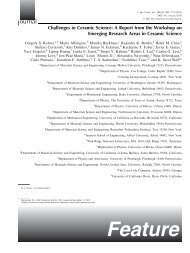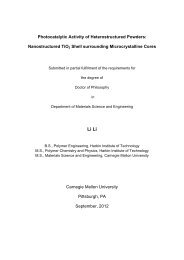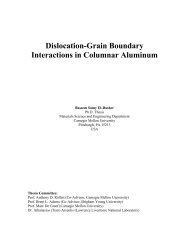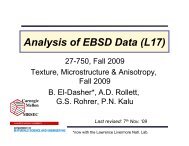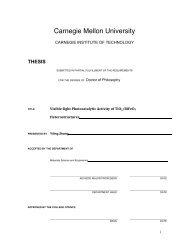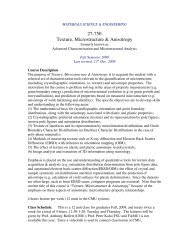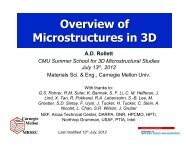¶ 3. Mathematical Representation of Crystal Orientation, Misorientation
¶ 3. Mathematical Representation of Crystal Orientation, Misorientation
¶ 3. Mathematical Representation of Crystal Orientation, Misorientation
You also want an ePaper? Increase the reach of your titles
YUMPU automatically turns print PDFs into web optimized ePapers that Google loves.
<strong>3.</strong>B.1 Miller index representation <strong>of</strong> orientation.<br />
Miller indices can be used to represent an orientation and this is in fact the<br />
standard method in the materials literature to describe particular (“ideal”) orientations<br />
(“texture components”). The representation takes two forms, one for a full description <strong>of</strong><br />
orientation (sometimes referred to as “bi-axial alignment” in the thin film literature), and<br />
the second for an implied fiber texture. In the first form, a sample is assumed to have a<br />
rectangular shape with large enough aspect ratio that a place normal can be associated<br />
with the face with largest area, and a direction with the longest dimension. In the case <strong>of</strong><br />
rolled sheets, these two are the rolling plane normal (ND, or RPN) and the rolling<br />
direction (RD), respectively.<br />
To describe an orientation, the convention is to specify the crystallographic plane<br />
normal that is parallel to the specimen normal (e.g. the ND) and a crystallographic<br />
direction that is parallel to the long direction (e.g. the RD). Looking ahead, this is akin to<br />
working in the space <strong>of</strong> an inverse pole figure, in that we specify which crystal direction<br />
can be found when we look along a fixed sample direction.<br />
(hkl) // ND, [uvw] // RD, or (hkl)[uvw]<br />
In effect, one is writing down the direction cosines † <strong>of</strong> the specimen’s third and first axes<br />
with respect to the crystallographic axes. Think about this carefully because, although<br />
one has used a crystallographic description, the quantities described are associated with<br />
the reference frame fixed in the specimen.<br />
† See Ch. 2 for definitions <strong>of</strong> quantities such as direction cosines<br />
8/27/09 4



